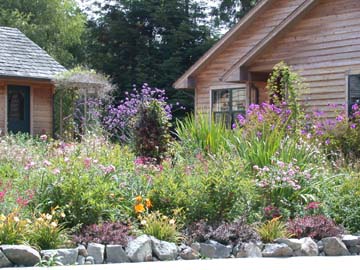|
Sept. 2, 2004
HBGF garden tourby AMY STEWART USUALLY, WHEN I GO TO PREVIEW A GARDEN THAT WILL BE ON THE Humboldt Botanical Garden Foundation's annual Garden Tour, major renovations are under way. Most gardeners see the tour as an excuse to finish up projects they've been planning for years. New beds are dug, paths are laid, benches are installed. Sometimes I've even seen a new deck under construction in the weeks leading up to the tour. But this year, when I went to
visit the Cutten garden of the Journal's own Sue Dodd,
things were different. There were no last-minute projects under
way, no blooming annuals getting pushed into the ground where
perennials had died back. Sure, Sue was outside when I arrived,
but she was just watering. For a woman whose garden was about
to be open to the public, she looked completely relaxed. She
even offered me a beer. (I told her I'd better not drink on the
job.) Part of the reason for her laid-back attitude is that, after five years of hard work, the garden is just about finished. The house, which Sue designed herself, sits far enough back from the street to allow plenty of gardening space in the front. She started with nothing but hard clay, had several dump trucks of rich black compost brought in, and started to plant. "I started with annuals, just planting them from seed," she said, "but the weeds came up faster than the flowers did. I had a yard full of waist-high weeds. The neighbors must have thought I was crazy. But my mom, who was living with me at the time, went out and bought some perennials. And those worked." The weeds weren't the only problem.
"About half my front yard got killed off two years ago when
we had an especially wet winter," she said. "Everything
sloped towards the house, and it just got so wet that nothing
survived. So every time I went to the nursery I filled my car
up with bags of compost. I brought 480 bags into this yard and
completely changed the slope. There are a few plants, like this
rosemary, that are still too damp, but the drainage problem's
mostly solved now." Her front garden looks surprisingly good for this late in the summer. Although the day lilies have mostly stopped blooming, the tall purple verbena and penstemon are still going strong, the princess flower, with its brilliant purple blossoms, stands out and provides a little privacy around the house. Containers line the brick patios and walkways which, by the way, she also built herself. "That's eight pallets of bricks, with 600 bricks in each pallet. I hired a bricklayer to do some of the work around the driveway, but I laid all four patios." [Maggie helping in the garden.] A person can get pretty tired just listening to Sue describe all the work that went into creating this garden, especially when you consider the fact that she was working full-time and taking care of her mother during the last five years. Behind the house, the lot slopes steeply into a greenbelt. The lot is so steep that the deck sits up at eye level with the redwoods. She built a fence in the back to delineate the end of her garden and the beginning of the woods. When the house was being built, she had the contractor push fill dirt down toward the fence to level it out somewhat. She's also used concrete rubble from a neighbor's demolished driveway, firewood, garden trimmings, and fallen branches to level the lot and build small retaining walls. And every time she expanded the garden in the back, she had to fight her way through the Himalayan blackberry vines. "I just hacked them back with brute force," she said. "That's the only thing they respond to." Ferns from the greenbelt line the walkway around the back of the house and fill out some of the steeper slopes, giving an illusion of much more level ground. The ferns also help provide a transition from the cheerful, colorful jumble in the front to the more subdued and woodsy garden in the back. Now, five years after she began, there's very little left to do. Flowers need to be deadheaded, an occasional weed needs to be pulled, but for the most part, the garden is finished. I got a little worried about what Sue might do with her time now that there are no more pallets of bricks or truckloads of dirt to distribute, so I asked her about her plans. "What am I going to do?" she said. "I'm going to rest! I'll sit down and drink a beer and enjoy it!" We'll see about that. Meanwhile, be sure and get your tickets early so you can have a look at Sue's garden and 11 others that are on the tour this year. The gardens are all located in Cutten, Humboldt Hill, Loleta and Fortuna. The site for the new Humboldt Botanical Garden will also be on the tour. Tea and scones will be served at the National Wildlife Refuge's Richard Guadagno Visitor Center, across Highway 101 from the Humboldt Botanical Garden. The event takes place on Sunday, Sept. 12, from 10 a.m. to 5 p.m.. Tickets are $15 for members and $20 for non-members. You'll find them on sale at nurseries and garden shops, and at the HBGF business office. For more information call HBGF at 442-5139 or visit www.hbgf.org. garden-related announcements and news to Amy Stewart. IN
THE NEWS | COVER STORY | PUBLISHER | STAGE DOOR © Copyright 2004, North Coast Journal, Inc. |



